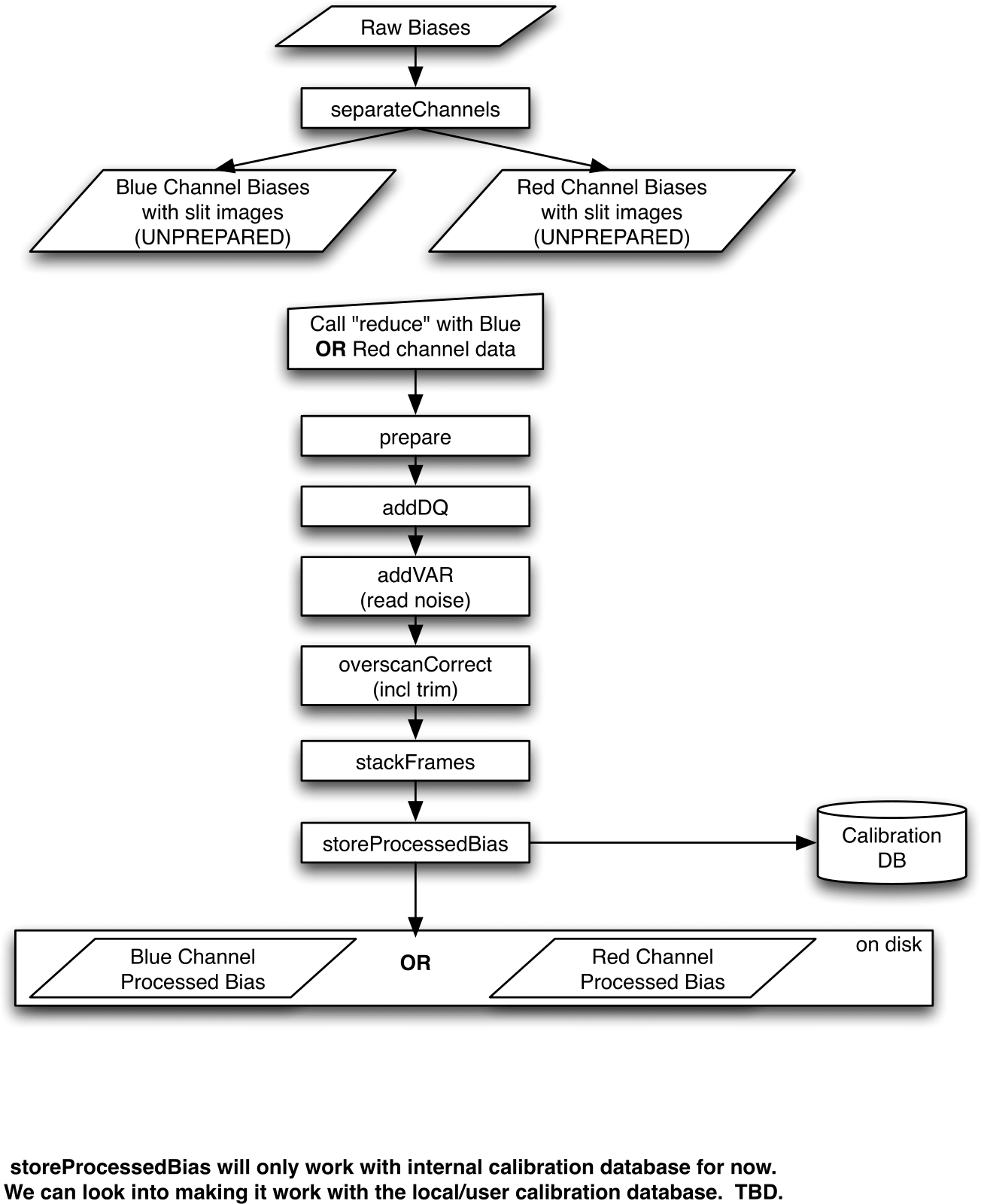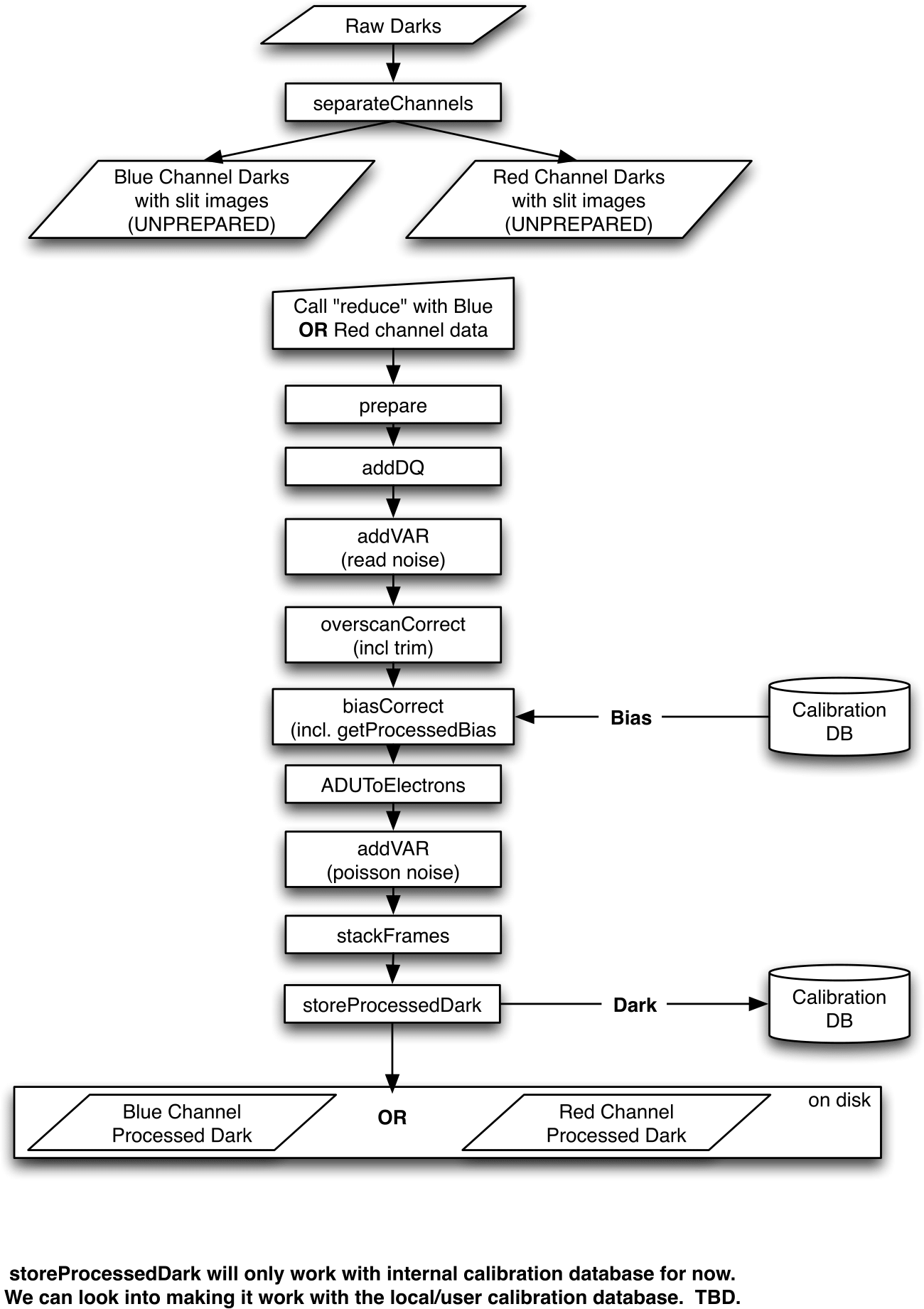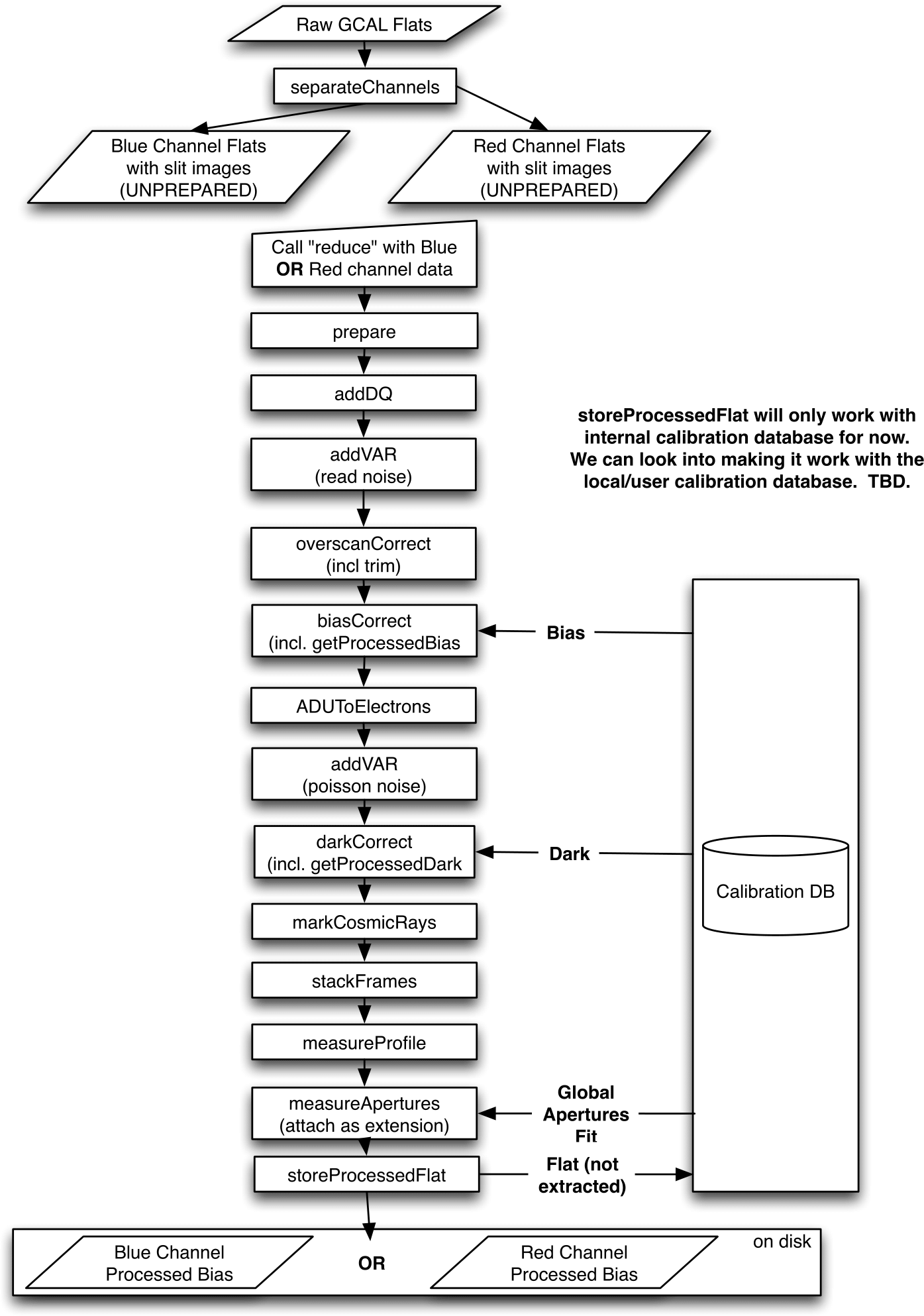3. Recipes for GHOST¶
3.1. Typical Processing Flows¶
Here we review some of the typical processing workflows for GHOST data
reduction. For this discussion, it is assumed you’ve already installed the
latest Ureka package and made a local clone of the ghostdr Hg repository.
(For illustrative purposes, the text below assumes the clone’s working copy
root is wc/.)
Furthermore, for the commands given below to work properly, you must:
- initialize the Ureka environment:
ur_setup- create a symlink named
wc/externals/gemini_python/astrodata_GHOSTpointing towc/astrodata_GHOST,- add
wc/externals/gemini_pythonto the beginning of yourPYTHONPATH, and- add
wc/externals/gemini_python/astrodata/scriptsandwc/externals/ gemini_python/recipe_system/appsto the beginning of yourPATH
3.1.1. Generating a Bias Calibration frame¶
To generate a bias calibration frame you need 2 or more GHOST bias frames from
the same arm. Until the instrument is live, you can use the GHOST simulator to
generate this data. Its testsim.py script will create several types of
frames, including 3 bias frames for each arm, 3 darks for each arm, and 3 flats
for each arm and resolution combination. You can comment out the generation of
non-bias frame types to speed things up.
Once you have a few biases of the same arm to work with, generate a file list
using the typewalk utility. The following command assumes you have
generated several red arm biases (if you don’t specify either GHOST_RED or
GHOST_BLUE, you may get mixed red and blue frames which don’t stack well!):
typewalk --types GHOST_BIAS GHOST_RED --dir <path_to>/data_folder -o bias.list
Now you are ready to generate a bias calibration frame. The following command
(which runs the makeProcessedBiasG Gemini recipe behind the scenes) will
stack the bias frames in listed bias.list and store the finished bias
calibration in calibrations/storedcals/:
reduce @<path_to>/bias.list
Don’t forget the @ character in this line, e.g. if <path_to> is data then
this command should be reduce @data/bias.list. The @ parameter is a legacy
from IRAF, and tells reduce that you’re passing a list of filenames instead
of a data file.
This code call will place a file named bias_1_red_bias.fits in the
calibrations/storedcals directory of your present working directory.
The whole process behind Gemini’s makeProcessedBias recipe is documented in
the following flowchart (thanks Kathleen Labrie):

3.1.2. Generating a Dark Calibration Frame¶
The procedure for generating a dark calibration frame is broadly similar to
making a bias calibration frame. However, the type to be passed to typewalk
should be GHOST_DARK instead of GHOST_BIAS (in addition to the
necessary GHOST_RED/GHOST_BLUE type):
typewalk --types GHOST_DARK GHOST_RED --dir <path_to>/data_folder -o dark.list
Assuming typewalk has output your list of dark frames to dark.list,
attempting to run:
reduce @<path_to>/dark.list
will fail. This is because the framework cannot currently find calibrations
stored on disk (it uses a much more complicated lookup scheme). The workaround
for the time being is to force it to look on disk in a particular area using the
--override_cal option:
reduce @<path_to>/dark.list --override_cal processed_bias:calibrations/storedcals/bias_1_red_bias.fits
(Depending on your specific bias.list contents, your bias calibration under
your calibrations/storedcals directory may have a different name, so double-
check.) This command will place a file dark95_1_red_dark.fits into the
calibrations/storedcals directory.
The whole process behind Gemini’s makeProcessedDark recipe is documented in
the following flowchart (thanks Kathleen Labrie):

3.1.3. Generating a Flat Calibration Frame¶
The procedure for generating a flat field calibration frame is similar to
creating a dark or bias, although you have to typewalk over GHOST_FLAT files
instead, e.g.:
typewalk --types GHOST_FLAT GHOST_RED GHOST_HIGH --dir <path_to>/data_folder -o flat.list
(Note this is the first place where we have to explicitly specify the
resolution mode/type of the object file we ultimately intend to reduce.)
Then, when you call reduce on the flat.list, you must provide both
the bias and dark file path explicitly:
reduce @<path_to>/flat.list --override_cal processed_bias:calibrations/storedcals/bias_1_red_bias.fits processed_dark:calibrations/storedcals/dark95_1_red_dark.fits
(or whatever the filename of the processed dark turns out to be).
After the flat field has been created, the spectrograph apertures are fit using
a polyfit approach. The RecipeSystem will read in the appropriate aperture
model from the lookups system, fit it to the flat field, and store the
resulting model in the calibrations system.
The selection of the appropriate polyfit model to start with is
determined by the spectrograph arm, resolution, and the date the observations
are made on. Ideally, there will only be one model per arm and resolution
combination; however, spectrograph maintenance (i.e. dis- and re-assembly) may
result in the model changing at a specific point in time. Therefore, the
RecipeSystem should (see below) automatically choose the most recent
applicable model for the dataset being considered.
Note
Date-based model selection is currently not implemented - instead, only a single model is provided for each arm/resolution combination. This is sufficient for testing involving the simulator data. Date-based selection will be implemented soon.
The process behind makeProcessedFlatG is summarized in the following
flowchart (thanks Kathleen Labrie):

Note
This is the originally-envisaged implementation of
makeProcessedFlatG. It has since been decided that Gemini will
guarantee that Gemini Observatory will always take at least three
flat fields per arm per observation, which means that
rejectCosmicRays is not required; stackFrames will remove
almost all cosmic rays.
3.1.4. Generating an Arc Calibration Frame¶
Warning
You must have performed a full slit viewer reduction before attempting to make an arc calibrator - the results of the slit flat and slit image reduction are required to make the profile extraction and subsequent wavelength fitting work. See Reducing Slit Viewing Images for details.
Making an arc calibration frame is similar to the previous calibration steps.
The correct type to typewalk across is GHOST_ARC:
typewalk --types GHOST_ARC GHOST_RED GHOST_HIGH --dir <path_to>/data_folder -o arc.list
Additional calibrators required are reduced slit viewer flats and slit viewer images, as well as the aperture fit made during the generation of the flat calibration image:
reduce @<path_to>/arc.list --override_cal processed_bias:calibrations/storedcals/bias_1_red_bias.fits processed_dark:calibrations/storedcals/dark95_1_red_dark.fits processed_slit:calibrations/storedcals/obj95_1.0_high_SLIT_stack_slit.fits processed_slitflat:calibrations/storedcals/flat95_high_1_SLIT_stack_slitFlat.fits processed_xmod:calibrations/storedcals/GHOST_1_1_red_high_xmodPolyfit.fits
Arc reduction not only generates a reduced arc image and places it in the
calibrations directory, but also uses the polyfit module to extract the
flux profiles of the object/sky fibres in the input image. It then uses this
fit, and a line set stored in the RecipeSystem lookups system, to make a
wavelength fit to the arc image. This fit is also stored in the calibrations
directory/system.
3.1.5. Reducing an Object frame (Spectra)¶
The GHOST simulator produces object spectra frames like
obj95_1.0_std_red.fits whose names follow this convention:
obj{exptime}_{seeing}_{resolution}_{arm}.fits. If you run typewalk on
the folder containing these, you’ll see that they are identified as
GHOST_OBJECT:
typewalk --dir <path_to>/data_folder
This informs the reduction framework to run the reduceG GHOST recipe on
them. which should run to at least the flatCorrect step now that you
have dark and bias calibration frames (for the moment, we have commented the
remaining steps out of the reduceG recipe so it will complete
successfully):
reduce <path_to>/data_folder/obj95_1.0_high_red.fits
The above command will fail due to the faulty calibrations lookup. Again, we
need to use the --override_cal option:
reduce <path_to>/data_folder/obj95_1.0_high_red.fits --override_cal processed_bias:calibrations/storedcals/bias_1_red_bias.fits processed_dark:calibrations/storedcals/dark95_1_red_dark.fits processed_flat:calibrations/storedcals/flat95_high_1_red_flat.fits
This produces a obj95_1.0_high_red_flatCorrected.fits (or similar) file, a
bias, dark and flat corrected GHOST spectrum frame.
Warning
The primitive rejectCosmicRays would normally be called as
part of reduceG, after the darkCorrect step. It is
currently commented out - the underlying LACosmic algorithm is
working, but aperture removal/re-instatement is required to avoid
accidentally flagging spectral peaks and the edges of orders as
cosmic rays, and this has yet to be implemented.
3.1.6. Reducing Slit Viewing Images¶
Reducing slit viewer images is very similar to reducing standard images,
including steps to generate bias, dark and flat calibration frames, plus a
final step to process the slit viewer frames (which removes cosmic rays and
computes the mean exposure epoch). The first step, computing the bias
calibrator, may be skipped in favour of simply pointing to a slit bias frame
(of type GHOST_SLITV_BIAS). Or, follow these steps to produce one by
stacking multiple frames together:
typewalk --types GHOST_SLITV_BIAS --dir <path_to>/data_folder -o slit_bias.list
reduce @<path_to>/slit_bias.list
The next step is to generate the dark calibrator. Follow these steps to produce one:
typewalk --types GHOST_SLITV_DARK --dir <path_to>/data_folder -o slit_dark.list
reduce @<path_to>/slit_dark.list --override_cal processed_bias:calibrations/storedcals/bias_1_SLIT_stack_slitBias.fits
Now generate the flat calibrator. For this you will now need to specify an
additional type to typewalk that identifies the resolution of the data that
you wish to process (as mixing resolutions would be nonsensical). Follow these
steps as an example:
typewalk --types GHOST_SLITV_FLAT GHOST_HIGH --dir <path_to>/data_folder -o slit_flat_high.list
reduce @<path_to>/slit_flat_high.list --override_cal processed_bias:calibrations/storedcals/bias_1_SLIT_stack_slitBias.fits processed_dark:calibrations/storedcals/dark95_1_SLIT_stack_slitDark.fits
The final step is to use all of the above calibrators in a call to reduce a
set of slit viewer images taken concurrently with a science frame, usually found
in files named like obj95_1.0_high_SLIT.fits (following this convention:
obj{exptime}_{seeing}_{resolution}_SLIT.fits). If you run typewalk on
the folder containing these, you’ll see that they are identified as
GHOST_SLITV_IMAGE. This informs the reduction framework to run the
makeProcessedSlitG GHOST recipe on them. Run the reduction as follows
(note that the flat is provided to --override_cal as process_slitflat
and not simply processed_flat):
reduce <path_to>/data_folder/obj95_1.0_high_SLIT.fits --override_cal processed_bias:calibrations/storedcals/bias_1_SLIT_stack_slitBias.fits processed_dark:calibrations/storedcals/dark95_1_SLIT_stack_slitDark.fits processed_slitflat:calibrations/storedcals/flat95_high_1_SLIT_stack_slitFlat.fits
3.2. Other Processing Flows¶
include scientific flow charts, include associated recipes